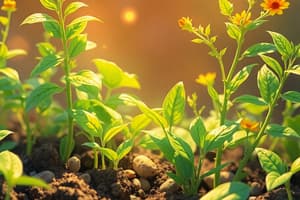Podcast
Questions and Answers
Is cation exchange capacity the measure of the amount of hydrogen ions in a solution?
Is cation exchange capacity the measure of the amount of hydrogen ions in a solution?
False (B)
Is humification the process by which soil organic matter is changed into humus?
Is humification the process by which soil organic matter is changed into humus?
True (A)
Do plants remove carbon for photosynthesis but do not return it through respiration?
Do plants remove carbon for photosynthesis but do not return it through respiration?
False (B)
Is a soil pH of 8-14 considered acidic?
Is a soil pH of 8-14 considered acidic?
Do macro-organisms such as earthworms and bacteria convert soil organic matter into humus?
Do macro-organisms such as earthworms and bacteria convert soil organic matter into humus?
Is nutrient recycling caused by Nitrogen Fixation, which turns nitrogen gas into nitrates?
Is nutrient recycling caused by Nitrogen Fixation, which turns nitrogen gas into nitrates?
Is the total amount of living material in a habitat referred to as soil Biomass?
Is the total amount of living material in a habitat referred to as soil Biomass?
Do plants such as clover have tiny nodules in their roots where live bacteria called nitrogen-fixing bacteria convert nitrogen gas into nitrates?
Do plants such as clover have tiny nodules in their roots where live bacteria called nitrogen-fixing bacteria convert nitrogen gas into nitrates?
Is the activity of living organisms in the soil affected by soil pH?
Is the activity of living organisms in the soil affected by soil pH?
Is a soil pH of 7 considered neutral?
Is a soil pH of 7 considered neutral?
Flashcards are hidden until you start studying
Study Notes
Chemical Properties of Soil
- Cation exchange capacity refers to the ability of soil to exchange cations, like calcium and hydrogen, influencing nutrient availability.
- Soil components, such as clay and humus, have the highest cation exchange capacity.
- Soil pH measures the concentration of hydrogen ions, affecting crop growth and soil organism activity.
- pH scale:
- 0-6 is acidic
- 7 is neutral
- 8-14 is alkaline.
Biological Properties of Soil Organisms
- Soil biomass encompasses all living organisms in the soil, including plants, animals, and microorganisms such as worms and bacteria.
- When these organisms die, they contribute to organic matter in the soil.
- Humification is the transformation of soil organic matter into humus, a beneficial component of fertile soil.
- Macro-organisms, including earthworms, and fungi, play crucial roles in converting organic matter into humus.
Role of Organisms in the Carbon Cycle
- Plants absorb carbon dioxide during photosynthesis and release it back into the atmosphere through respiration.
- Livestock acquire carbon by consuming plants and also release it via respiration.
- Nitrogen fixation is the process that converts nitrogen gas into usable nitrates, crucial for plant growth.
- Certain plants, such as clover, have root nodules containing nitrogen-fixing bacteria, which facilitate the conversion of nitrogen gas into nitrates.
Studying That Suits You
Use AI to generate personalized quizzes and flashcards to suit your learning preferences.




